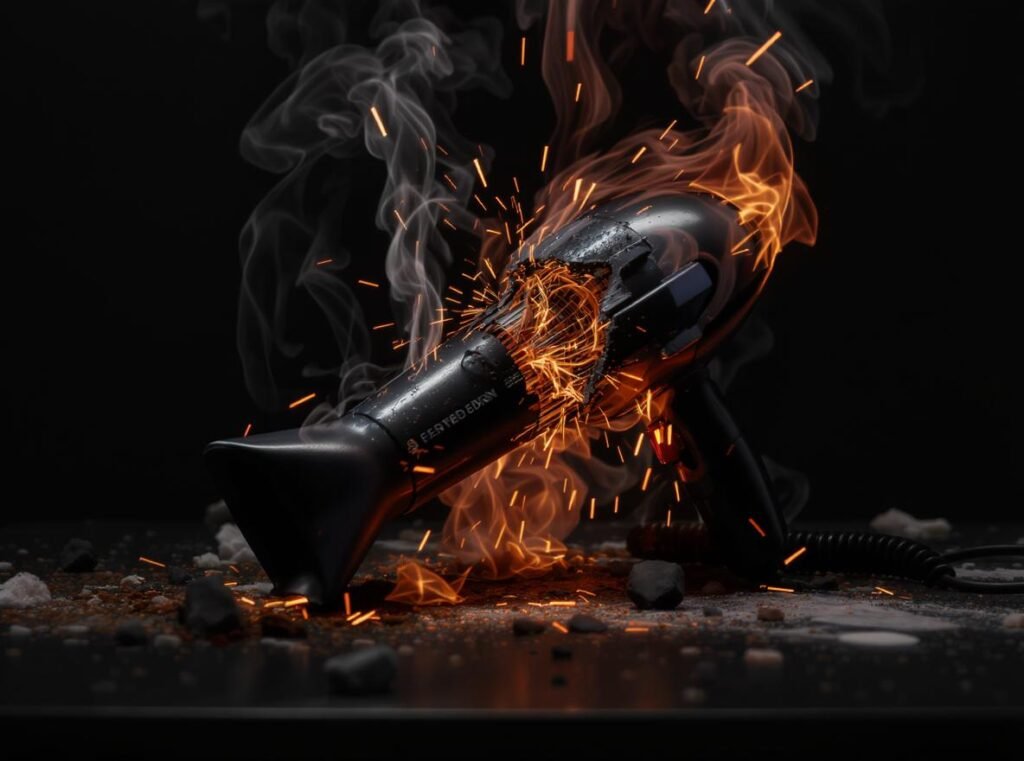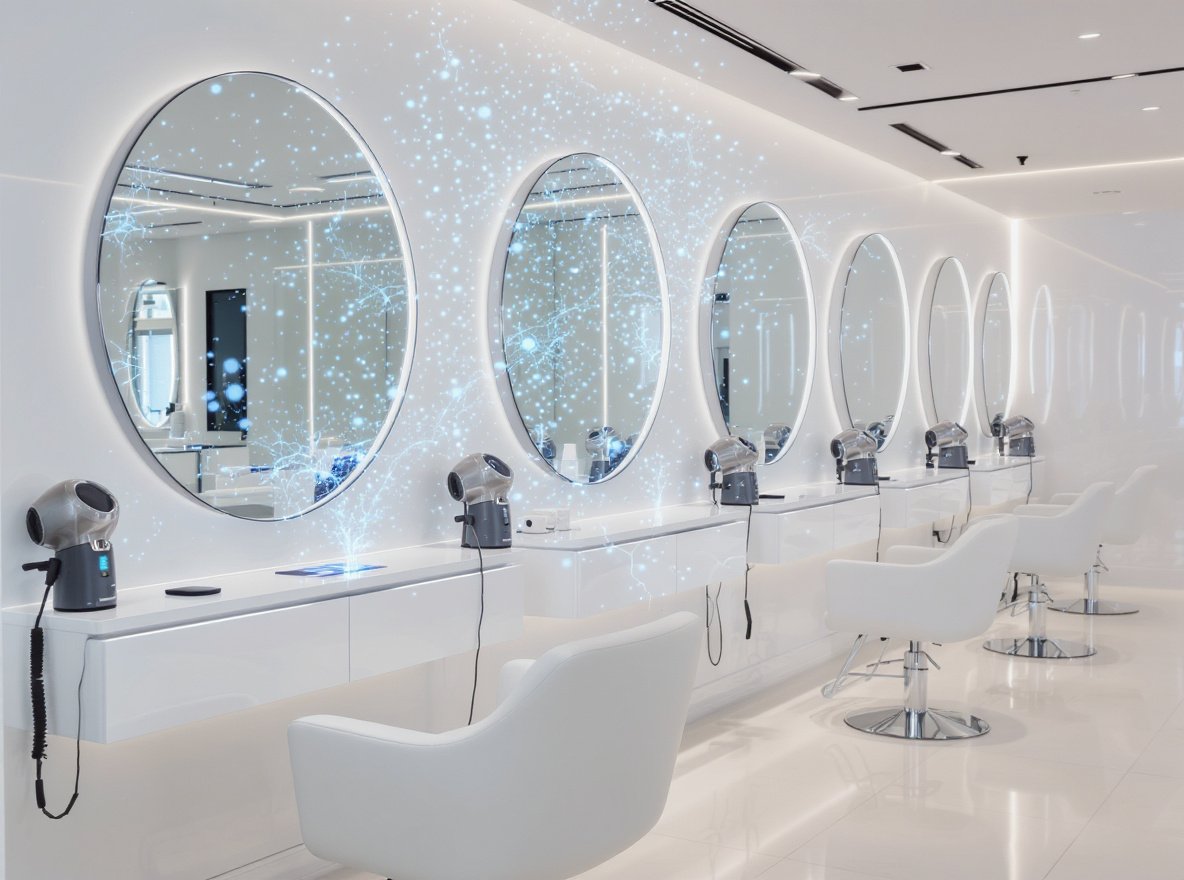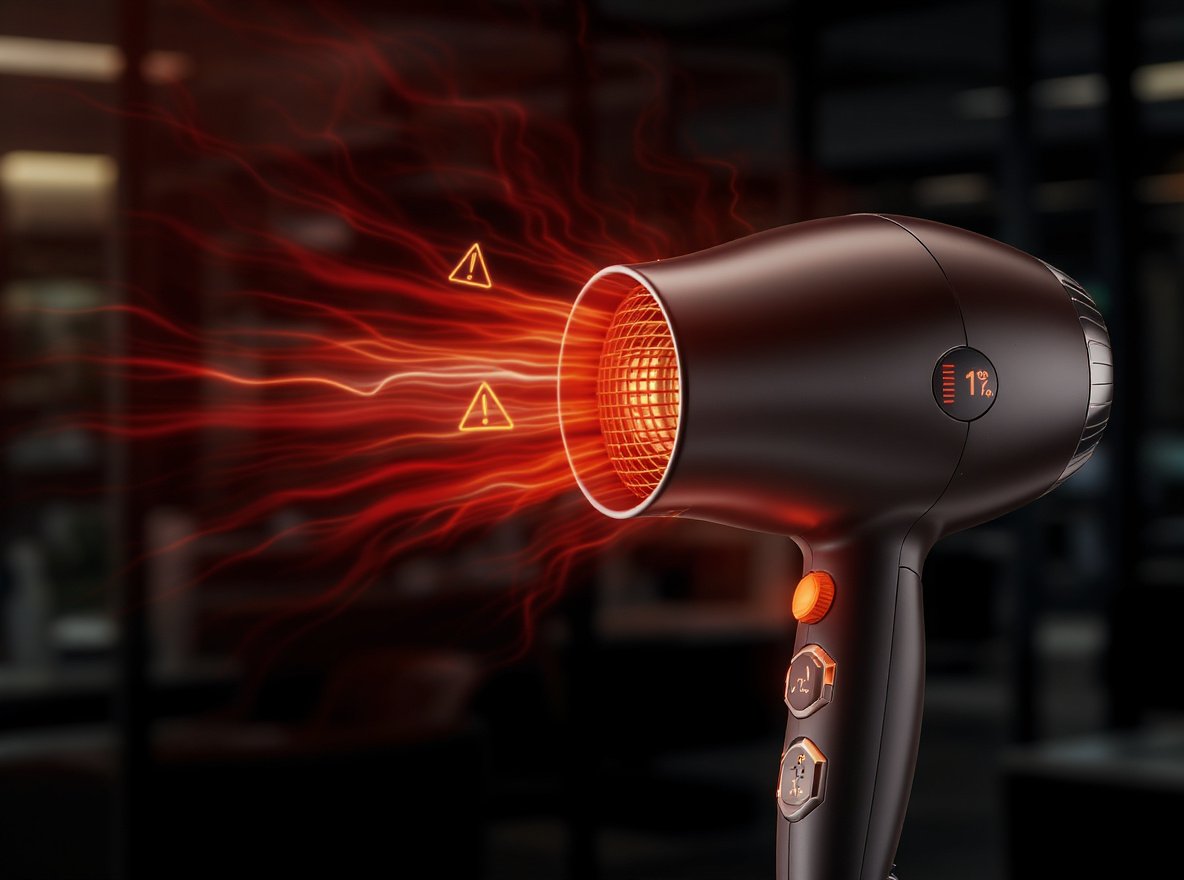Hair dryers are essential equipment for salons, distributors, and beauty professionals worldwide. However, recent incidents and safety recalls have raised important questions about fire and explosion risks that every business owner should understand.
Yes, hair dryers can catch fire and potentially explode under certain conditions. While explosions are rare, fires occur more frequently due to overheating, blocked vents, faulty wiring, and moisture exposure. Professional-grade equipment with proper safety features significantly reduces these risks.
Understanding these safety concerns protects your business, customers, and investment in quality equipment. Let’s examine the facts about hair dryer safety and prevention strategies.
Table of Contents
ToggleWhat Causes Hair Dryers to Catch Fire?
Every distributor and salon owner should understand the primary causes of hair dryer fires to make informed purchasing decisions and protect their business.
Hair dryer fires result from overheating due to blocked air vents, faulty wiring, moisture exposure, and manufacturing defects. Extended use without proper cooling and improper storage of hot units also create significant fire risks.
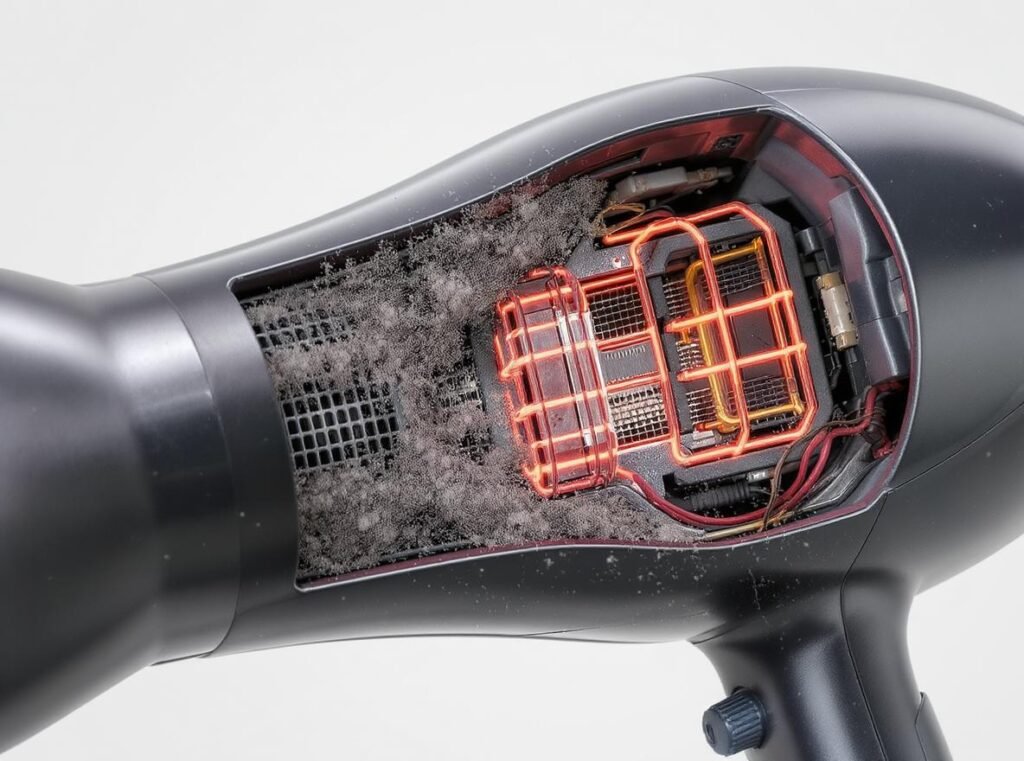
The leading cause is overheating from blocked air vents. When lint, dust, or hair accumulates in intake vents, airflow decreases dramatically. This forces heating elements to work beyond their design limits, creating dangerous temperatures that can ignite internal components.
Faulty wiring represents another major risk factor. Electrical faults in older models or damaged units can create sparks that ignite surrounding materials. Poor-quality manufacturing or non-compliance with safety standards increases these electrical hazards significantly.
Moisture exposure creates immediate fire and explosion risks. Water inside electrical components causes short circuits that can trigger fires or, in severe cases, explosive failures when the device remains energized.
Manufacturing defects and inadequate safety features leave users vulnerable to preventable accidents. Units that lack proper thermal protection or use substandard materials pose ongoing risks throughout their operational life.
| Fire Cause | Risk Level | Prevention Strategy |
|---|---|---|
| Blocked air vents | High | Regular cleaning, removable lint screens |
| Faulty wiring | High | Quality construction, proper storage |
| Moisture exposure | Critical | Water-resistant design, GFCI protection |
| Manufacturing defects | Medium | Certified safety standards, reputable brands |
Can Hair Dryers Actually Explode?
The explosion risk requires careful explanation to help businesses understand actual versus perceived dangers in their operations.
Hair dryers can explode in rare circumstances, typically when they fall into water while plugged in or experience severe internal pressure buildup from overheating. Most “explosions” are actually motor failures that create loud sounds and component ejection rather than true explosive events.
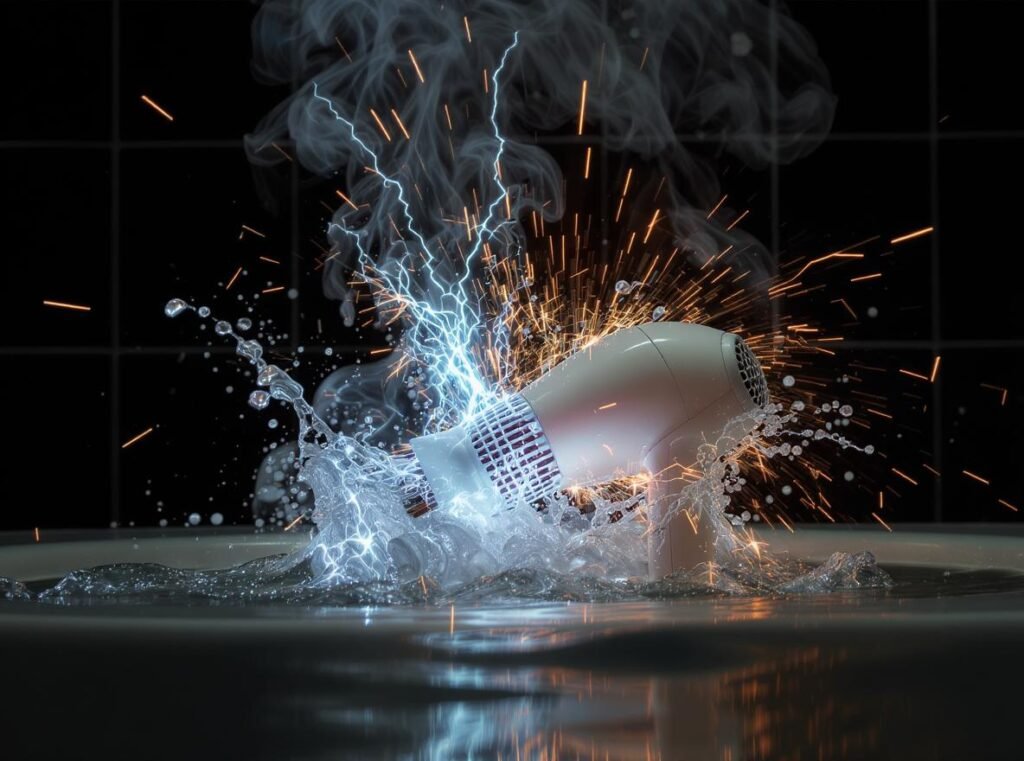
Real-world incidents provide important context for business owners. A documented case in Calgary involved a hair dryer causing a nearby shampoo aerosol can to explode, demonstrating how dryers can trigger secondary explosions through heat exposure to pressurized containers.
Motor failures represent the most common “explosive” scenario. When motors seize while powered, electrical components can fail rapidly, creating loud popping sounds and potential part ejection. While dramatic, these failures typically remain localized to the device itself.
The distinction between direct and indirect explosion risks matters for safety planning:
- Direct risks involve catastrophic failure of the dryer’s internal components, usually accompanied by electrical arcing and component ejection. These events are rare but can cause injuries and property damage.
- Indirect risks include igniting nearby flammable materials or causing aerosol products to explode from heat exposure. These scenarios often cause more extensive damage than direct failures.
Professional-grade equipment with proper safety systems significantly reduces explosion risks through thermal protection, pressure relief mechanisms, and superior construction quality.
What Are the Warning Signs of a Dangerous Hair Dryer?
Recognizing early warning signs prevents accidents and protects both staff and customers from potentially dangerous situations.
Warning signs include burning smells, unusual noises, visible damage to cords or housing, sparking, excessive heat, and performance changes. Fire services recommend immediate replacement when any of these indicators appear.
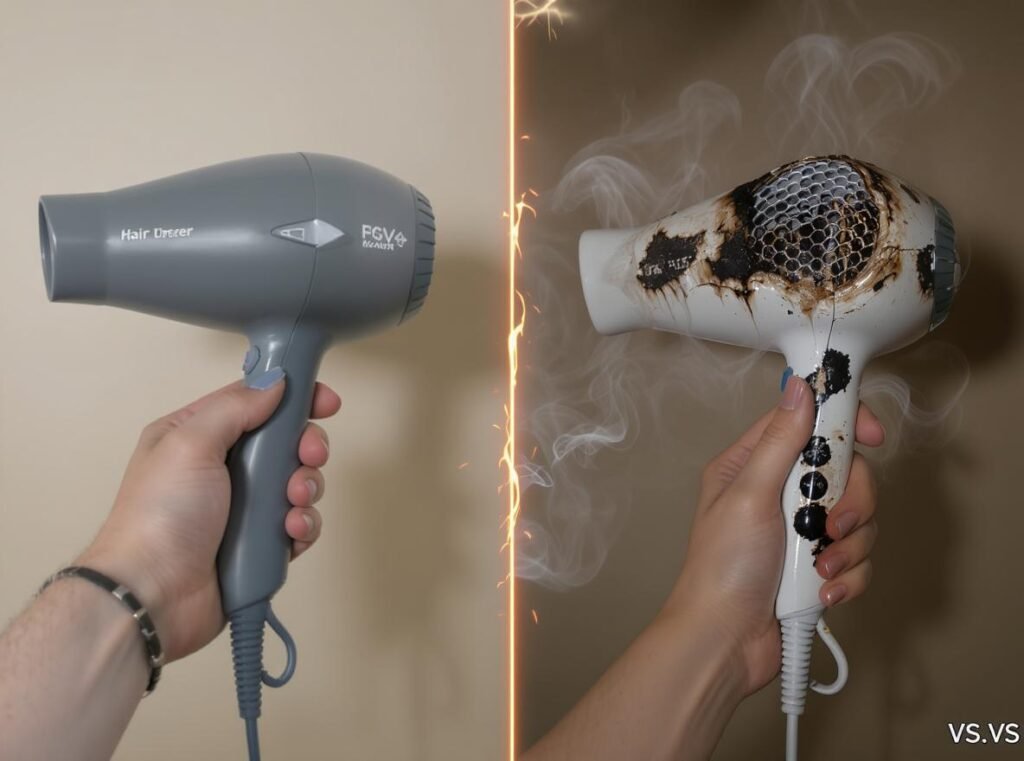
Olfactory warning signs provide the earliest alerts:
Burning smells indicate overheating internal components or deteriorating wiring insulation. These odors typically appear before visible signs of damage and should trigger immediate discontinuation of use.
Unusual chemical smells suggest plastic components are overheating or electrical insulation is failing. These conditions can rapidly progress to fire situations.
Audio indicators reveal mechanical problems:
Grinding or squealing sounds indicate motor bearing failure or internal mechanical damage. Continued operation under these conditions can lead to catastrophic failure.
Crackling or popping noises suggest electrical arcing or component failure. These sounds often precede electrical fires and require immediate attention.
Visual inspection reveals obvious hazards:
Examine power cords for fraying, kinks, melted areas, or exposed wires. Damaged cords create both fire and electrocution hazards that require immediate replacement.
Check housing for cracks, melted areas, or discoloration that indicate overheating. These visual signs often accompany internal damage that compromises safety.
Performance changes signal developing problems:
Inconsistent heating, reduced airflow, or intermittent operation indicate internal component failure. Address these issues immediately rather than continuing operation.
How Can You Prevent Hair Dryer Fires?
Prevention strategies protect your business investment while ensuring consistent, safe operation for staff and customers.
Regular maintenance, proper storage, quality equipment selection, and staff training prevent most hair dryer fires. Industry experts recommend establishing cleaning schedules and replacement protocols based on usage intensity.
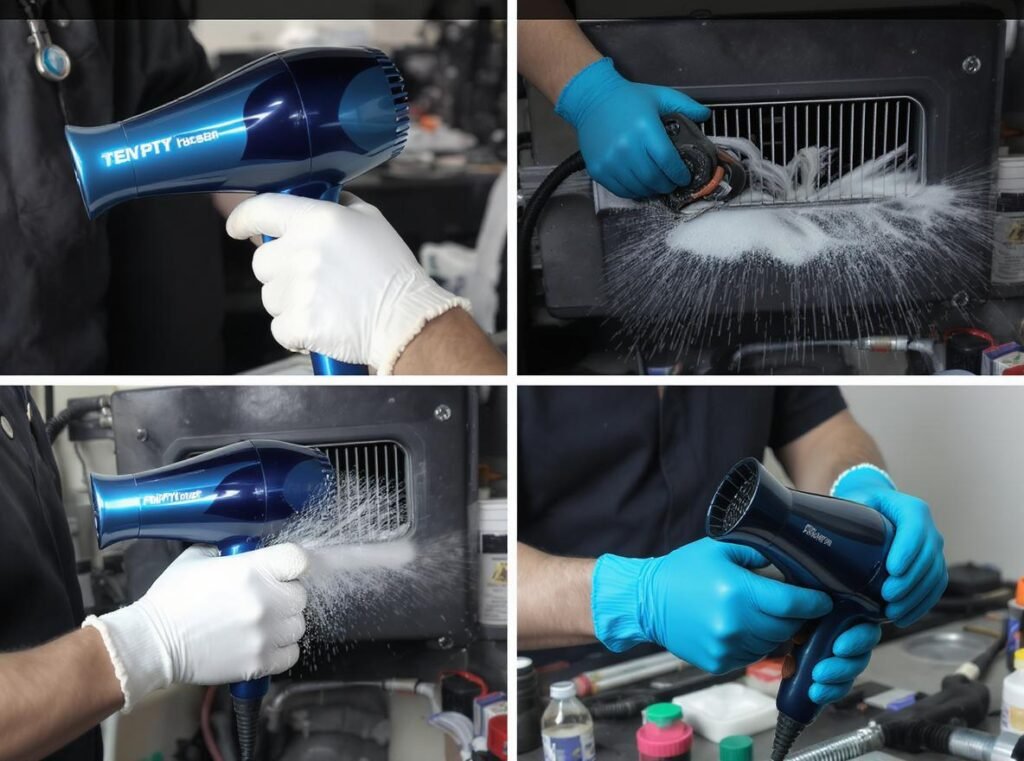
Maintenance protocols should include:
- Daily cleaning of air intake vents in high-volume professional settings using compressed air or soft brushes. Weekly cleaning suffices for lower-volume operations.
- Monthly inspection of power cords, housing, and connections for signs of wear or damage. Document these inspections to track equipment condition over time.
- Quarterly professional servicing for commercial-grade equipment ensures internal components remain in safe operating condition.
Storage practices significantly impact fire prevention:
- Always unplug dryers after use and allow complete cooling before storage. Hot units stored in confined spaces can ignite surrounding materials.
- Store equipment in dry, well-ventilated areas away from flammable materials. Ensure adequate spacing between units to prevent heat buildup.
- Never store dryers with cords wrapped tightly around the unit, as this can damage wiring and create fire hazards.
Usage guidelines reduce operational risks:
- Avoid continuous operation beyond manufacturer recommendations. Most professional dryers require cooling breaks after 20-30 minutes of intensive use.
- Train staff to recognize warning signs and respond appropriately. Regular safety briefings help maintain awareness and prevent accidents.
- Use correct voltage settings and ensure electrical systems can handle equipment demands. Overloaded circuits create fire hazards beyond the dryer itself.
What Safety Features Should You Look for in Hair Dryers?
Modern safety features significantly reduce fire and explosion risks while providing better performance and reliability for professional use.
Essential safety features include thermal protection, automatic shut-off mechanisms, GFCI compatibility, removable lint screens, and certified construction. Professional models should exceed basic safety requirements with multiple redundant protection systems.
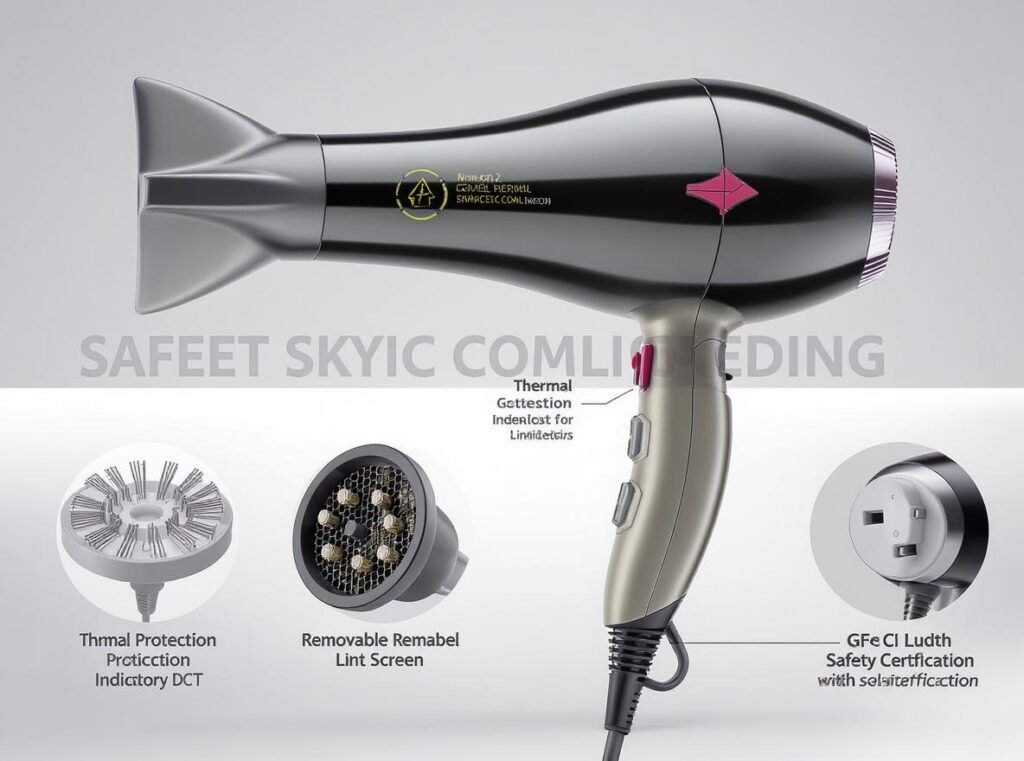
Thermal protection systems form the foundation of dryer safety:
Safety cut-off switches monitor internal temperatures and automatically shut down operations when safe limits are exceeded. This prevents overheating that could lead to fires.
Thermal fuses provide backup protection by breaking electrical circuits when temperatures or currents exceed safe parameters. These components sacrifice themselves to prevent fires.
Bimetallic strips offer additional thermal protection by physically disconnecting power when internal temperatures rise excessively. This mechanical system works independently of electronic controls.
Electrical safety features protect against shock and fire:
GFCI (Ground Fault Circuit Interrupter) protection prevents electrical shock hazards, especially important in wet environments typical of salons and spas.
Proper insulation prevents exterior surfaces from becoming dangerously hot during operation. Quality insulation also reduces energy waste and improves efficiency.
Enhanced wiring with superior materials and connections reduces the risk of electrical failures that could spark fires.
Maintenance-friendly design features improve long-term safety:
Removable lint screens allow easy cleaning and reduce fire risks from accumulated debris. These screens should be accessible without tools.
Protective screens and grills prevent debris from entering internal components while protecting users from heating elements.
Durable construction with quality materials ensures safety features remain effective throughout the product’s operational life.
| Safety Feature | Function | Business Benefit |
|---|---|---|
| Thermal Cut-off | Prevents overheating | Reduces fire liability |
| GFCI Protection | Electrical shock prevention | Customer safety compliance |
| Removable Filters | Easy maintenance | Lower service costs |
| Auto Shut-off | Prevents user error | Operational safety |
Are Professional Hair Dryers Safer Than Consumer Models?
The safety distinction between professional and consumer hair dryers involves significant differences in construction, features, and regulatory compliance.
Professional hair dryers typically offer superior safety features, more robust construction, and better thermal management compared to consumer models. However, safety depends more on adherence to recognized safety standards and built-in protection systems than simply professional versus consumer labeling.
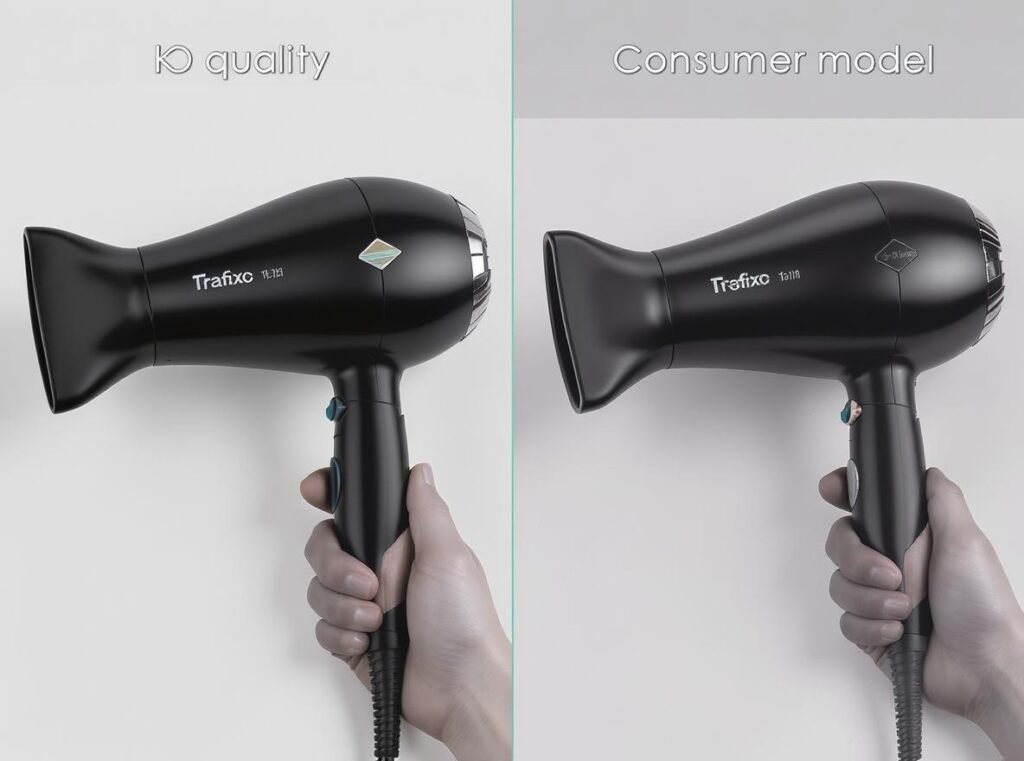
Construction quality differences impact safety significantly:
Professional models use higher-grade materials, superior electrical components, and more sophisticated motor designs. These improvements translate to longer lifespans and reduced failure rates that protect business investments.
Thermal management systems in professional dryers distribute heat more evenly and include enhanced cooling mechanisms. Better heat distribution reduces hot spots that could cause fires.
Electrical systems in professional models often include multiple protection circuits, better insulation, and more robust wiring. These features significantly reduce electrical failure risks.
However, professional designation alone doesn’t guarantee safety. Key factors include:
Certification from recognized safety organizations like UL, CE, or equivalent standards bodies. These certifications ensure products meet specific safety requirements regardless of market positioning.
Manufacturer reputation and support quality matter more than marketing claims. Established brands with proven track records provide better safety assurance.
Availability of replacement parts and qualified service ensures long-term safety through proper maintenance and repair capabilities.
Consumer models vary widely in safety features and construction quality. Premium consumer models often include professional-grade safety features, while budget options may lack essential protections.
The critical factor is choosing equipment that meets or exceeds recognized safety standards rather than relying on professional versus consumer classifications alone.
What Should You Do if a Hair Dryer Catches Fire?
Emergency response procedures can prevent injuries and minimize property damage when hair dryer fires occur in professional settings.
If a hair dryer catches fire, immediately unplug the device or shut off the circuit breaker, use a Class C fire extinguisher designed for electrical fires, and evacuate if the fire cannot be quickly controlled. Never use water on electrical fires.
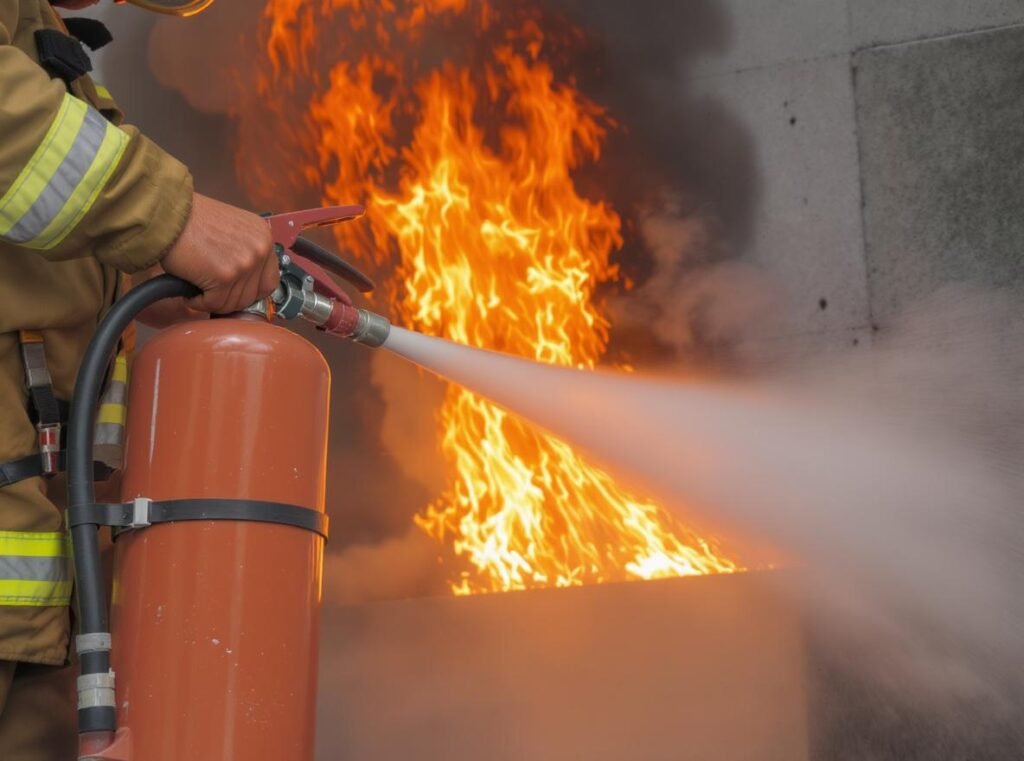
Immediate response actions save lives and property:
Disconnect power immediately by unplugging the device or shutting off the circuit breaker for the area. This eliminates the energy source feeding the fire.
Use appropriate fire suppression methods. Class C fire extinguishers are designed for electrical fires and won’t conduct electricity like water-based suppressants.
Remove nearby flammable materials if it can be done safely. Hair products, towels, and other salon materials can fuel fire spread.
Call emergency services immediately if the fire cannot be controlled within seconds. Professional firefighters have equipment and training to handle electrical fires safely.
Post-incident procedures protect your business:
Document the incident thoroughly with photos and detailed descriptions. This information helps with insurance claims and identifies potential systemic problems.
Contact the manufacturer to report the fire. Many companies track safety incidents and may issue recalls or safety notices based on pattern recognition.
Have your electrical system inspected by a qualified electrician. Hair dryer fires can indicate broader electrical problems that need addressing.
Review and update your emergency procedures based on the incident. Use the experience to improve staff training and safety protocols.
How Often Should Hair Dryers Be Replaced?
Establishing replacement schedules prevents safety issues while maintaining optimal performance and protecting business investments.
Industry experts recommend replacing hair dryers every 5 years or sooner if warning signs appear. High-volume professional use may require more frequent replacement every 3-4 years, while lower-volume operations can extend replacement intervals with proper maintenance.
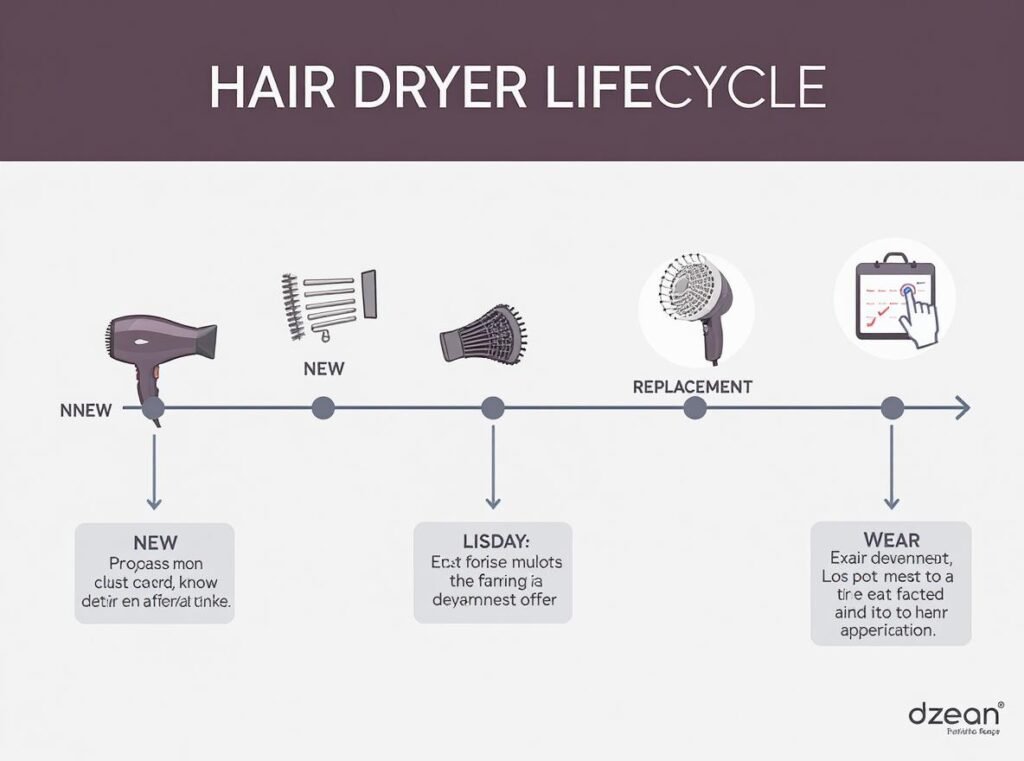
Usage intensity affects replacement timing significantly:
High-volume salon use creates accelerated wear on components, requiring more frequent replacement. Daily professional use stresses electrical and mechanical components beyond typical consumer usage patterns.
Medium-volume operations can typically achieve 4-5 year replacement cycles with proper maintenance and quality equipment selection.
Low-volume or intermittent use allows longer replacement intervals, but safety inspections remain crucial regardless of usage frequency.
Performance degradation indicators suggest replacement needs:
Reduced air velocity despite clean vents indicates motor or fan deterioration that compromises efficiency and safety.
Inconsistent heating patterns suggest electrical component degradation that can create fire risks.
Increased noise levels during operation indicate mechanical wear that can lead to failure.
Visible wear on housing, cords, or components signals the need for replacement before safety issues develop.
Cost-benefit analysis favors proactive replacement:
Replacing equipment before failure prevents emergency situations that can disrupt business operations and create liability concerns.
New equipment often includes improved safety features and energy efficiency that reduce operational costs.
Warranty coverage on new equipment provides protection against defects and safety issues that older units lack.
Quality professional models like the Conason P1C offer better value through longer lifespans, superior safety features, and lower total cost of ownership for business operations.
What Do Industry Experts Recommend for Hair Dryer Safety?
Professional organizations and safety experts provide authoritative guidance for safe hair dryer selection, use, and maintenance in commercial settings.
Industry experts emphasize regular maintenance protocols, quality equipment selection, staff training, and compliance with safety standards as the foundation of hair dryer safety. Professional associations recommend specific procedures for commercial environments.
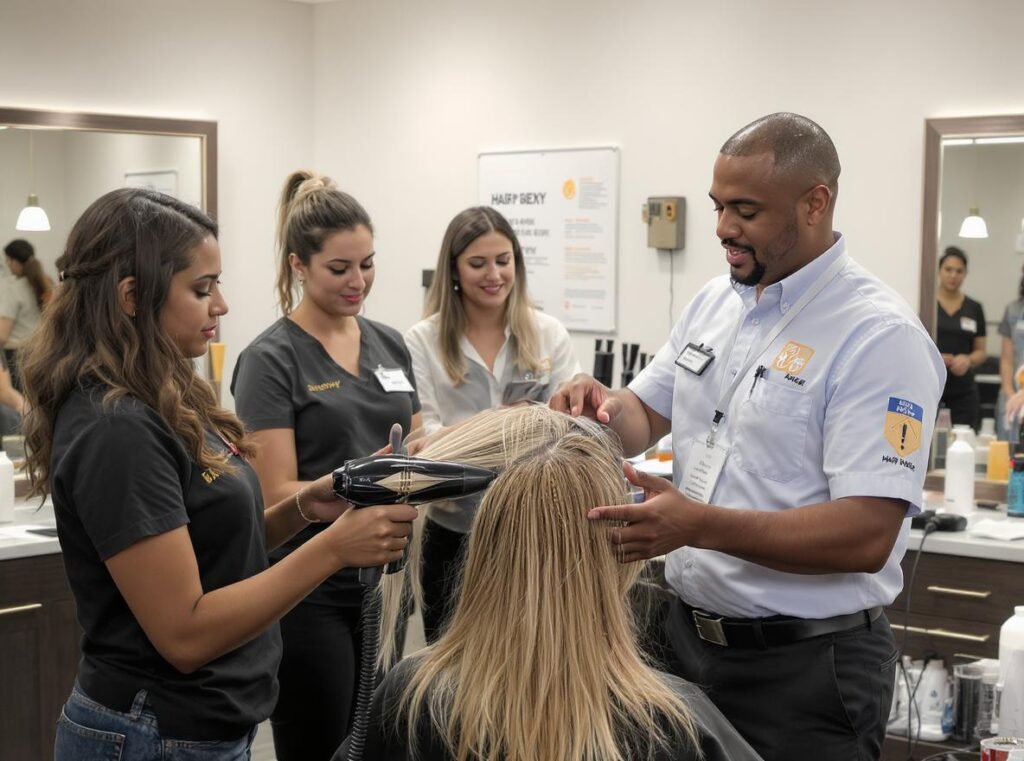
Maintenance protocols from industry leaders include:
Daily cleaning of air intake vents in professional settings to prevent lint accumulation that creates fire hazards.
Weekly inspection of power cords, housing, and connections for signs of wear, damage, or deterioration.
Monthly professional servicing for high-use environments ensures internal components remain in safe operating condition.
Annual safety audits for commercial facilities help identify potential problems before they become hazardous.
Training recommendations ensure staff competency:
Proper handling techniques minimize wear and tear on equipment while maximizing safety. This includes correct cord management, appropriate storage methods, and recognition of warning signs.
Emergency response procedures ensure staff know how to react to equipment failures. Regular drills help maintain readiness and prevent panic during actual incidents.
Safety awareness training helps staff recognize and report potential hazards before they become dangerous situations.
Equipment selection criteria emphasize safety over cost:
Certification from recognized safety organizations provides assurance that products meet established safety standards.
Manufacturer reputation and support quality ensure long-term safety through proper service and parts availability.
Compatibility with existing electrical systems prevents overloading and reduces fire risks.
Professional organizations recommend establishing relationships with qualified service providers who understand commercial hair dryer requirements and safety protocols.
Regular safety updates and continuing education help maintain current knowledge of best practices and emerging safety technologies.
Summary
Hair dryer safety requires understanding risks, implementing prevention strategies, and selecting quality equipment with proper safety features. While fires and explosions are possible, regular maintenance, staff training, and professional-grade equipment significantly reduce these risks. Proactive replacement schedules and emergency preparedness protect businesses, staff, and customers from preventable accidents.
For wholesale buyers seeking reliable, safe hair dryers, the Conason P1C incorporates multiple safety features including thermal protection, automatic shut-off, and professional-grade construction that meets international safety standards. Our complete product collection offers various models designed for different business needs, all featuring comprehensive safety systems that protect your investment and ensure customer safety. Contact us for wholesale pricing and technical specifications that demonstrate our commitment to safety and quality in professional hair care equipment.

